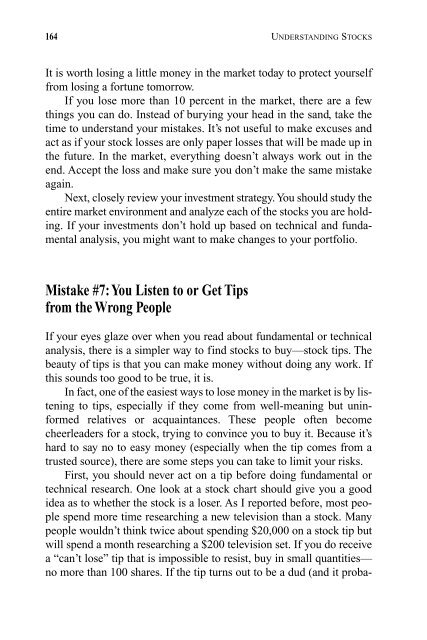Understanding Stocks
Understanding Stocks
Understanding Stocks
You also want an ePaper? Increase the reach of your titles
YUMPU automatically turns print PDFs into web optimized ePapers that Google loves.
164 UNDERSTANDING STOCKS<br />
It is worth losing a little money in the market today to protect yourself<br />
from losing a fortune tomorrow.<br />
If you lose more than 10 percent in the market, there are a few<br />
things you can do. Instead of burying your head in the sand, take the<br />
time to understand your mistakes. It’s not useful to make excuses and<br />
act as if your stock losses are only paper losses that will be made up in<br />
the future. In the market, everything doesn’t always work out in the<br />
end. Accept the loss and make sure you don’t make the same mistake<br />
again.<br />
Next, closely review your investment strategy. You should study the<br />
entire market environment and analyze each of the stocks you are holding.<br />
If your investments don’t hold up based on technical and fundamental<br />
analysis, you might want to make changes to your portfolio.<br />
Mistake #7:You Listen to or Get Tips<br />
from the Wrong People<br />
If your eyes glaze over when you read about fundamental or technical<br />
analysis, there is a simpler way to find stocks to buy—stock tips. The<br />
beauty of tips is that you can make money without doing any work. If<br />
this sounds too good to be true, it is.<br />
In fact, one of the easiest ways to lose money in the market is by listening<br />
to tips, especially if they come from well-meaning but uninformed<br />
relatives or acquaintances. These people often become<br />
cheerleaders for a stock, trying to convince you to buy it. Because it’s<br />
hard to say no to easy money (especially when the tip comes from a<br />
trusted source), there are some steps you can take to limit your risks.<br />
First, you should never act on a tip before doing fundamental or<br />
technical research. One look at a stock chart should give you a good<br />
idea as to whether the stock is a loser. As I reported before, most people<br />
spend more time researching a new television than a stock. Many<br />
people wouldn’t think twice about spending $20,000 on a stock tip but<br />
will spend a month researching a $200 television set. If you do receive<br />
a “can’t lose” tip that is impossible to resist, buy in small quantities—<br />
no more than 100 shares. If the tip turns out to be a dud (and it proba-

















